


 National Academy of Agricultural Sciences (NAAS)
National Academy of Agricultural Sciences (NAAS)

|
PRINT ISSN : 2319-7692
Online ISSN : 2319-7706 Issues : 12 per year Publisher : Excellent Publishers Email : editorijcmas@gmail.com / submit@ijcmas.com Editor-in-chief: Dr.M.Prakash Index Copernicus ICV 2018: 95.39 NAAS RATING 2020: 5.38 |
A field experiment was conducted on clay loam soils of Agricultural College Farm, Bapatla, Guntur (A P) during rabi 2009-10 and 2010-11 to study the influence of plant density and fertilizer N on productivity and nutrient uptake of rice fallow maize under no-till conditions. Yield attributes (cob length, number of kernels cob-1, kernel weight cob-1 and shelling percentage) were significantly higher at lower planting density but, kernel (79.3 and 81.7 q ha-1) and stover yields (101.1 and 100.4 q ha-1) were significantly higher at 100000 plants ha-1 than that recorded with 67000 plants ha-1 but was on a par with 80000 plants ha-1. Harvest index was also higher with lower planting density of 67000 plants ha-1(46.0 and 46.1%) than that recorded with higher level of planting density (100000 plants ha-1) (43.9 and 44.8%). Nutrient uptake was significantly superior with higher level of planting density. However, soil fertility status reduced with increase in planting density from 67000 to 100000 plants ha-1. Application of N significantly increased yield attributes, yields and net returns during both the years. The maximum kernel yield was recorded with application of 300 kg N ha-1 (81.3 and 85.3 q ha-1) but was statistically on par with 240 kg N ha-1 (77.5 and 79.0 q ha-1). The uptake of N, P and K by maize at harvest was significantly higher with higher plant density and higher level of N application. The available N-P-K status of the soil was higher due to the enhanced levels of nutrients to the soil. The highest net returns and benefit cost ratio (BCR) were obtained in the treatment of higher planting density (100000 plants ha-1) in combination with 300 kg N ha-1.
 |
 |
 |
 |
 |